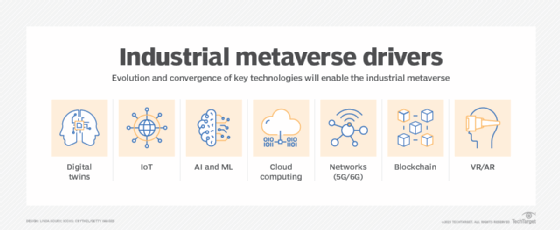Nvidia Omniverse
What is Nvidia Omniverse?
Nvidia Omniverse is a computing platform built to enhance digital design and development by integrating 3D design, spatial computing and physics-based workflows across Nvidia tools, third-party apps and artificial intelligence (AI) services. Created specifically for developing applications in the metaverse, the real-time platform is used for building digital twins of products, factories, warehouses and infrastructure. It can also streamline the creation of 3D-related media for entertainment and product demonstrations, as well as enterprise media content rendered on computers, phones and extended reality (XR) devices.
The platform, launched in 2022, is available as a cloud service or a private instance running on premises. Additionally, it supports plugins and integrations for deploying omniverse content, applications and autonomous control systems across cars, robots, building controls, equipment and medical devices.

Why is Nvidia Omniverse important?
Nvidia Omniverse helps streamline workflows for designing, simulating and optimizing equipment, products and processes across different roles and expertise for virtual design. For example, Mercedes-Benz and BMW are using it to improve their product and factory designs. It is also helping companies optimize mobile network deployment, warehouse layouts, building construction and smart city deployments.
The platform can also serve as an integration tier for workflows that span tools from different vendors. This can reduce the integration challenges in crafting point-to-point integrations for specific workflows. For example, teams could use design tools from one vendor, simulation tools from another and rendering engines from a third to streamline virtual development efforts.
Nvidia Omniverse, through its Omniverse Replicator and Isaac Sim components, can also help generate synthetic data for testing various autonomous systems, AI algorithms and robot control systems. This function can streamline the development of more capable autonomous cars, warehouse materials handling equipment and robotic controls. The final control software can be sent to various target controllers, including Nvidia-specific embedded hardware or third-party controllers supporting standards such as Unified Robot Description Format or Robot Operating System.
In addition, Nvidia Omniverse also supports more consumer-facing development for generating avatars, asking questions about physical products and visualizing the furniture layout in a 3D representation of rooms.
Components that constitute Nvidia Omniverse
The Omniverse platform supports various components across physical representations, core platform elements and extensible integration capabilities.
Physical representations
Omniverse supports various specifications and standards that simplify the exchange of 3D-related data across multiple tools. Nvidia is working with the Universal Scene Description (USD) community to extend the specification to support Material Definition Language (MDL) and PhysX capabilities.
Nvidia's suite of tools for creating 3D content
USD is a standardized format for exchanging and describing 3D scenes, enabling users to streamline collaboration across over 50 3D data file formats.
MDL represents textures, reflections and opacity of 3D surfaces.
PhysX describes objects' mechanical and fluid properties and interactions.
Core platform
The core Nvidia Omniverse platform includes the following elements for storing, connecting, simulating, rendering and developing apps:
- Nucleus. A collaboration engine and database for storing, versioning and sharing project data across apps and workflows.
- Connect. A framework and suite of tools for connecting and synchronizing data across design, engineering and rendering tools.
- Kit. A software development kit for building customized apps, tools and user experiences using C++ and Python.
- Simulation. A collection of Nvidia technologies that connects 3D assets to various simulation engines.
- RTX Renderer. A rendering engine that can scale across multiple graphical processing unit engines for various rendering tasks, including experiencing virtual worlds across computer, mobile and XR devices.
Extended ecosystem
The essential value of the Nvidia Omniverse platform comes from its support of a rich collection of Nvidia, third-party, and open source tools and formats. These include plugins, extensions or services, such as the following:
- Omniverse USD Composer. Helps assemble large 3D models spanning multiple components from different sources.
- Omniverse Audio2Face. Uses generative AI to generate realistic facial expressions on 3D avatars.
- Isaac Sim. A development and testing platform for robots and their algorithms that supports simulation and can export designs to computer-aided design (CAD) systems and robot controllers. Simulates robot designs and controllers exported to control systems.
- Metropolis. Integrates camera and internet of things data into machine vision workflows in cities and industrial quality control.
- Clara. Streamlines the development of medical devices and imaging applications.
- Drive. Helps design and test autonomous vehicle control systems.
- SimReady Assets. Simplifies the exchange of data across diverse types of simulations.
- Warehouse Creator. Helps build virtual warehouses to improve logistics and autonomous robot control systems.
- Omniverse Replicator. Generates synthetic data for testing robots, autonomous cars and industrial control systems.
- Omniverse Launcher. Automates downloading, installating and updating Omniverse app connectors for users.
How can businesses utilize Nvidia Omniverse?
Nvidia Omniverse helps streamline the development lifecycle of physical products and virtual experiences across various roles and expertise. The platform can help businesses manage the complexity of building new products, designing more efficient facilities and creating more engaging user experiences. Here are some specific ways the platform is used by businesses:
- Improving performance and reducing the cost of physical products, such as cars, chips and wind farms. Understanding tradeoffs between product design and factory processes.
- Streamlining collaboration across mechanical, electrical and fluid engineering disciplines.
- Prototyping new factory designs to understand bottlenecks earlier in the process.
- Optimizing the layout of cellphone towers for cost-effective wireless coverage.
- Inspecting products to identify and fix defects more efficiently.
- Creating realistic 3D avatars to improve customer experiences.
- Explaining product benefits and use cases.
- Displaying products in virtual replicas of homes, offices and facilities.
- Facilitating improved 3D content collaboration among artists, experience designers and product leads.
- Optimizing the layout of warehouses for faster material handling.
- Testing mobile robots and human workflows to improve robot controllers.
- Developing robot controllers to speed learning and improve precision.
- Designing and testing new medical devices and software more efficiently.
Potential future of Nvidia Omniverse
Nvidia Omniverse is currently the most comprehensive platform for integrating 3D and physics-based workflows across various cloud services, third-party applications and rendering engines. The platform's tools and supporting services ecosystem have been undergoing rapid innovation. In the short term, Nvidia said it will continue to improve the integration of 3D workflows with its AI hardware and tools.
Nvidia is also actively working with various industry groups and standards bodies to improve the capabilities of multiple standards, specifications and open source tools. For example, it is a member of the OpenXR community, developing standards to streamline XR and spatial computing experiences across different devices. It is also helping guide the Graphics Library Transmission Format standard for exchanging 3D content for consumer-facing applications. Additionally, it is helping to extend the USD format beyond 3D scenes to support more complex engineering and simulation workflows. Nvidia will continue to help weave these capabilities into the Omniverse platform.
The platform also supports a rich marketplace to make it easier for vendors, domain experts and systems integrators to monetize their expertise and services. It will continue to enrich these offerings. These enhance the ability for enterprise users to mix and match design, development, test and monitoring capabilities across various tools. Nvidia currently has partnerships with leading product lifecycle management, geographic information system, CAD, computer-aided engineering, simulation and gaming engine vendors. Nvidia Omniverse will continue to streamline workflows across these tools.








